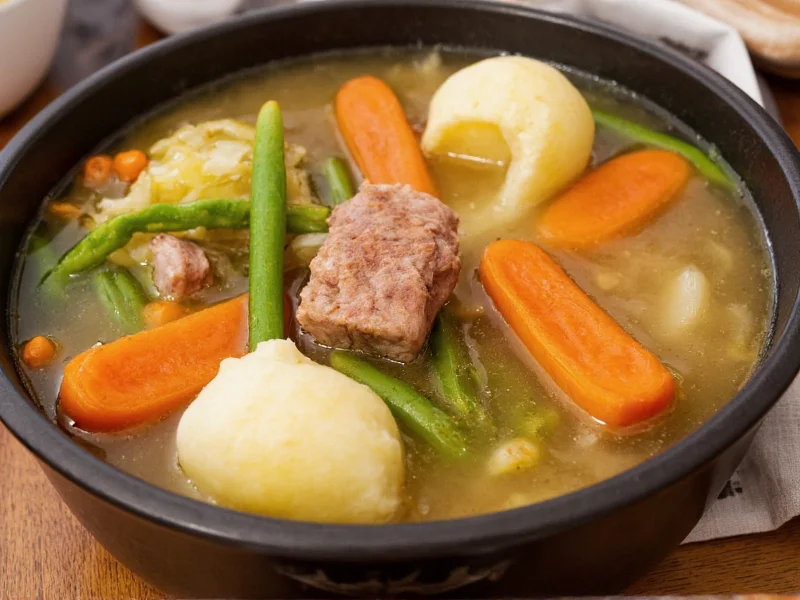This traditional comfort food combines humble vegetables with pork bones to create a nourishing meal that's been enjoyed across various cultures for generations. The slow simmering process extracts collagen and nutrients from the bones while allowing the vegetables to absorb the rich flavors of the broth. What makes this soup particularly valuable is its perfect balance of protein from the pork bones and essential vitamins from the colorful vegetables.
The Nutritional Powerhouse in Your Pot
Carrots, potatoes, and cabbage with pork bones soup isn't just comforting—it's packed with health benefits that make it worthy of regular rotation in your meal planning. The pork bones provide collagen, gelatin, and minerals like calcium and magnesium that support joint health and digestion. Meanwhile, the vegetable trio delivers a rainbow of nutrients:
| Vegetable | Key Nutrients | Health Benefits |
|---|---|---|
| Carrots | Vitamin A, beta-carotene, fiber | Supports vision, immune function, and skin health |
| Potatoes | Potassium, vitamin C, B6 | Regulates blood pressure and supports nerve function |
| Cabbage | Vitamin K, vitamin C, antioxidants | Promotes gut health and reduces inflammation |
When combined, these ingredients create a complete meal that satisfies hunger while delivering balanced nutrition. The soup's collagen content particularly stands out, as it supports skin elasticity and joint health—making this traditional recipe surprisingly aligned with modern wellness trends.
Authentic Recipe for Carrots Potatoes and Cabbage with Pork Bones Soup
Creating this soul-warming soup requires attention to detail but minimal active preparation time. The key to exceptional flavor lies in properly preparing the pork bones and timing the vegetable additions.
Ingredients for Traditional Pork Bone Vegetable Soup
- 2 pounds pork bones (preferably marrow bones or knuckle bones)
- 8 cups cold water
- 2 tablespoons apple cider vinegar (helps extract minerals from bones)
- 1 large onion, quartered
- 3 garlic cloves, smashed
- 2 carrots, peeled and chopped into 1-inch pieces
- 2 medium potatoes, peeled and cubed
- 3 cups green cabbage, chopped
- 1 celery stalk, finely chopped
- 1 bay leaf
- 1 teaspoon whole black peppercorns
- Salt to taste
- Fresh parsley for garnish
Step-by-Step Preparation Guide
- Prepare the bones: Rinse pork bones under cold water. For deeper flavor, roast bones in a 400°F oven for 20-30 minutes until lightly browned.
- Initial simmer: Place bones in a large pot with cold water, vinegar, onion, and garlic. Bring to a gentle boil, then reduce heat to maintain a bare simmer.
- Skim impurities: During the first 20 minutes, skim off any foam or impurities that rise to the surface for a clearer broth.
- Long simmer: Cover partially and simmer gently for 2-3 hours. The longer it simmers, the richer the flavor and more nutrients extracted.
- Add vegetables: After 2 hours, add carrots, potatoes, celery, bay leaf, and peppercorns. Simmer for 20 minutes.
- Final additions: Add cabbage and continue simmering for another 15-20 minutes until all vegetables are tender but not mushy.
- Season and serve: Remove bay leaf and peppercorns. Season with salt to taste. Garnish with fresh parsley before serving.
Professional Tips for Perfect Pork Bone Vegetable Soup
As someone who's perfected this recipe through years of cooking, I've discovered several techniques that transform good soup into exceptional soup:
- Bone selection matters: Marrow bones create the richest broth, while knuckle bones add more collagen. A combination yields the best texture and flavor profile for carrots potatoes and cabbage with pork bones soup.
- Cold start is crucial: Always begin with cold water when making bone broth—this helps slowly extract flavors and nutrients rather than causing proteins to coagulate too quickly.
- Vinegar enhances nutrition: The small amount of apple cider vinegar isn't noticeable in the final taste but significantly increases mineral extraction from the bones.
- Vegetable timing: Add root vegetables first, then cabbage later to prevent overcooking. Cabbage breaks down faster than carrots and potatoes.
- Resting improves flavor: Let the soup sit off heat for 15-20 minutes before serving—this allows flavors to meld and creates a more harmonious taste.
Variations for Dietary Preferences
This adaptable recipe accommodates various dietary needs while maintaining its comforting essence:
- Lower sodium version: Omit added salt and use low-sodium tamari instead during serving for those monitoring sodium intake in their traditional pork bone soup recipe.
- Keto adaptation: Reduce potato quantity and add extra cabbage and celery for a lower-carb version of how to make cabbage potato soup with pork bones.
- Enhanced protein: Add shredded cooked pork shoulder during the last 10 minutes for a more substantial meal.
- Spicy variation: Include a dried red chili pepper during simmering for those who enjoy a kick in their nutritious vegetable soup with pork bones.
Storage and Reheating Guidelines
One of the beauties of this traditional soup is how its flavors deepen when stored properly:
- Refrigeration: Store in airtight containers for up to 5 days. The fat will solidify on top—this natural seal helps preserve freshness.
- Freezing: Freeze in portion-sized containers for up to 3 months. Thaw overnight in the refrigerator before reheating.
- Reheating: Warm gently over medium-low heat, stirring occasionally. Add a splash of water if the broth has thickened too much during storage.
- Flavor boost: When reheating, add a fresh bay leaf and a few peppercorns to refresh the flavors of your homemade pork bone vegetable soup.











 浙公网安备
33010002000092号
浙公网安备
33010002000092号 浙B2-20120091-4
浙B2-20120091-4